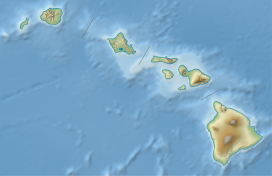Āliamanu Crater
| Āliamanu Crater | |
|---|---|
 Aerial view of Salt Lake (Āliapa‘akai) with Āliamanu Crater directly above | |
| Highest point | |
| Elevation | 760 ft (230 m) |
| Coordinates | 21°21′42″N 157°54′54″W / 21.36167°N 157.91500°W |
| Geography | |
| Location | Salt Lake, Hawaii, United States |
| Parent range | Hawaiian Islands |
| Geology | |
| Mountain type | Tuff cone |
| Volcanic arc | Hawaiian-Emperor seamount chain |
Āliamanu Crater, also known as Leilono Crater[1][2] or North Crater,[2] is a volcanic tuff cone in the Salt Lake neighborhood of Honolulu, Hawaii.[3]
It has an elevation of 760 feet,[4] towering the nearby Āliapa‘akai and Makalapa craters.
History
[edit]The first geological description of Aliamanu was done by 19th century geologist James Dwight Dana.[5]
In the early 20th century, the US military constructed a military base within the crater now known as the Aliamanu Military Reserve. The area was also used for underground ammunition storage.[4]
Geology
[edit]Āliamanu was one of the many tuff craters formed during the Honolulu Volcanics, a series of eruptions in southeastern Oahu.[3]
Legends
[edit]The Ancient hawaiians believed the upper rim of Aliamanu crater to be the location of Leilono, a site said to contain the entrance to the otherworld (Pō).[6]
Legends also record the Hawaiian goddesses Pele and Hiʻiaka using the crater as a habitat.[6]
References
[edit]- ^ "Hawaiian Place Names". ulukau.org. Retrieved May 5, 2023.
- ^ a b Decisions on Names in the United States. Department of the Interior. 1959.
- ^ a b "Geolex — Aliamanu publications". ngmdb.usgs.gov. Retrieved May 5, 2023.
- ^ a b Thompson, Erwin N. (1985). Pacific Ocean Engineers History of the U.S. Army Corps of Engineers in the Pacific, 1905–1980. U.S. Government Printing Office. p. 75.
- ^ Pankiwskyj, Kost A. "Geology of the Salt lake Area, Oahu, Hawaii". Pacific Science. 26: 244.
- ^ a b "Ka Makani Ho'eo o Moanalua The Ho'eo, whistling wind of Moanalua". Moanalua Ahupua'a: 44.

